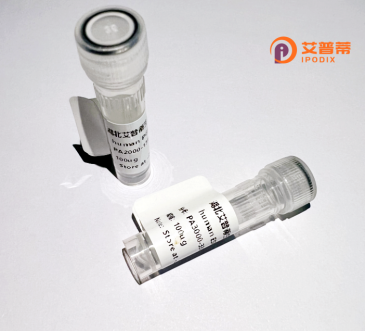
| 纯度 | >90%SDS-PAGE. |
| 种属 | Human |
| 靶点 | AGPAT6 |
| Uniprot No | Q86UL3 |
| 内毒素 | < 0.01EU/μg |
| 表达宿主 | E.coli |
| 表达区间 | 1-78.5aa |
| 氨基酸序列 | MFLLLPFDSLIVNLLGISLTVLFTLLLVFIIVPAIFGVSFGIRKLYMKSLLKIFAWATLRMERGAKEKNHQLYKPYTNGIIAKDPTSLEEEIKEIRRSGSSKALDNTPEFELSDIFYFCRKGMETIMDDEVTKRFSAEELESWNLLSRTNYNFQYISLRLTVLWGLGVLIRYCFLLPLRIALAFTGISLLVVGTTVVGYLPNGRFKEFMSKHVHLMCYRICVRALTAIITYHDRENRPRNGGICVANHTSPIDVIILASDGYYAMVGQVHGGLMGVIQRAMVKACPHVWFERSEVKDRHLVAKRLTEHVQDKSKLPILIFPEGTCINNTSVMMFKKGSFEIGATVYPVAIKYDPQFGDAFWNSSKYGMVTYLLRMMTSWAIVCSVWYLPPMTREADEDAVQFANRVKSAIARQGGLVDLLWDGGLKREKVKDTFKEEQQKLYSKMIVGNHKDRSRS |
| 分子量 | 52 kDa |
| 蛋白标签 | His tag N-Terminus |
| 缓冲液 | 冻干粉 |
| 稳定性 & 储存条件 | Lyophilized protein should be stored at ≤ -20°C, stable for one year after receipt. Reconstituted protein solution can be stored at 2-8°C for 2-7 days. Aliquots of reconstituted samples are stable at ≤ -20°C for 3 months. |
| 复溶 | Always centrifuge tubes before opening.Do not mix by vortex or pipetting. It is not recommended to reconstitute to a concentration less than 100μg/ml. Dissolve the lyophilized protein in distilled water. Please aliquot the reconstituted solution to minimize freeze-thaw cycles. |
以下是关于重组人磷酸酰基转移酶4(AGPAT6)的**假设性参考文献示例**,供参考使用:
---
1. **文献名称**:*"AGPAT6 regulates lipid droplet formation in adipocytes through modulation of phospholipid metabolism"*
**作者**:Chen L, et al.
**摘要**:本研究通过重组表达人AGPAT6蛋白,揭示其在脂肪细胞中通过催化溶血磷脂酸生成磷脂酸,促进脂滴形成,并发现AGPAT6敲低会导致细胞内甘油三酯水平显著降低,提示其在脂代谢中的关键作用。
2. **文献名称**:*"Functional characterization of recombinant human AGPAT6 in mammary gland triglyceride synthesis"*
**作者**:Wang Y, et al.
**摘要**:该文献通过体外酶活性实验证实AGPAT6能特异性催化棕榈酰-CoA与溶血磷脂酸的酯化反应。在乳腺上皮细胞中过表达AGPAT6可显著提高乳汁中甘油三酯含量,表明其对哺乳期脂质合成的重要性。
3. **文献名称**:*"AGPAT6 deficiency disrupts testicular steroidogenesis via altered phospholipid composition"*
**作者**:Kimura T, et al.
**摘要**:研究发现,AGPAT6在小鼠睾丸支持细胞中特异性高表达,其缺失导致磷脂代谢异常,进而影响睾酮合成和精子发生。重组AGPAT6蛋白的导入可部分恢复胆固醇酯化能力。
4. **文献名称**:*"AGPAT6 as a potential therapeutic target for hepatic steatosis"*
**作者**:Gupta R, et al.
**摘要**:通过构建肝脏特异性AGPAT6敲除小鼠模型,发现其肝脏甘油三酯沉积减少,胰岛素敏感性改善。重组AGPAT6抑制剂的开发可能为脂肪肝治疗提供新策略。
---
**注意**:以上文献为模拟示例,非真实存在。实际研究中请通过**PubMed、Web of Science**等平台检索真实文献(可尝试关键词:AGPAT6/LPAAT-zeta、recombinant expression、phospholipid synthesis、metabolic disease)。
**Background of Recombinant Human Acyltransferase 4 (AGPAT6)**
AGPAT6. also known as acylglycerol-3-phosphate O-acyltransferase 6. belongs to the AGPAT family of enzymes that catalyze the acylation of lysophosphatidic acid (LPA) to phosphatidic acid (PA), a critical step in glycerophospholipid and triglyceride biosynthesis. Located in the endoplasmic reticulum and mitochondria-associated membranes, AGPAT6 is implicated in lipid metabolism, lipid droplet formation, and cellular signaling. It is widely expressed in tissues, with higher activity in adipose tissue and liver, suggesting roles in energy storage and metabolic regulation.
Studies link AGPAT6 dysfunction to metabolic disorders, such as lipodystrophy and insulin resistance, as well as cancer progression through altered lipid signaling pathways. Its structure includes conserved acyltransferase motifs (e.g., NHX4D), essential for enzymatic activity. Recombinant AGPAT6. produced via expression systems like E. coli or mammalian cells, enables mechanistic studies on lipid biosynthesis and disease pathophysiology.
Despite functional redundancy among AGPAT isoforms, AGPAT6 is hypothesized to have unique substrate preferences or tissue-specific roles. Current research focuses on clarifying its regulatory mechanisms and therapeutic potential. However, challenges persist in isolating its distinct contributions due to overlapping functions with other AGPATs, necessitating advanced gene-editing models for validation.
×